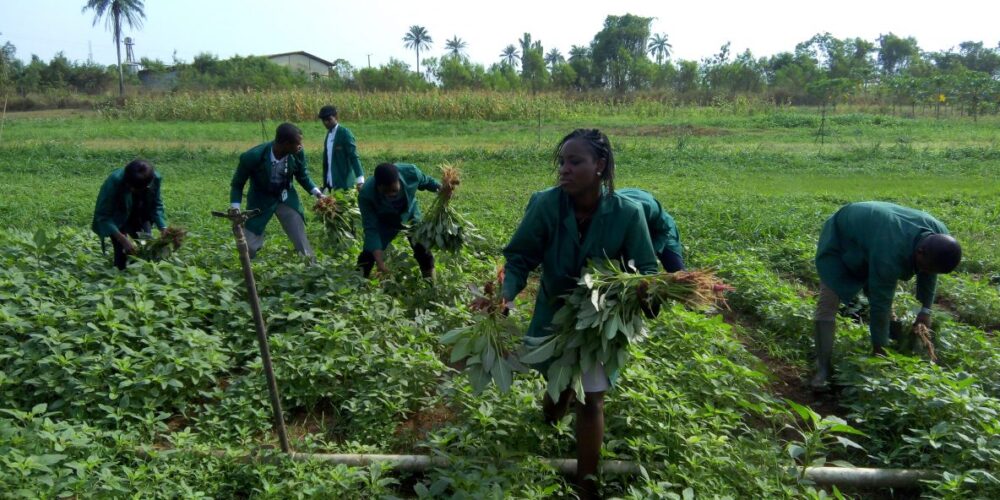9 min read
Summary: To address the concerns of food and nutrition insecurity, youth unemployment, and general economic growth and development, African governments have made agricultural transformation a priority on their policy agenda. Agriculture, unfortunately, has remained mainly unappealing to the general public, particularly the youth, for a variety of reasons, including low returns, a lack of infrastructure investment necessary for effective value chain development, and insufficient social protection. Food insecurity is not only a problem in developing countries; it is also a concern in industrialized countries. When youths are encouraged to participate in agricultural activities, food security can be easily achieved. This will help in the development of the agricultural sector, as well as increased production and food security.
Abstract
This study examines how the agricultural transformation will stimulate youth participation, thereby leading to food security in Nigeria. Information and Communication Technology (ICT) adoption, insurance and health care provision was used as transformation variables. The study applied the Propensity Score Matching (PSM) model on the data sourced from Wave 4 (2018/2019) of the Living Standard Measurement Study-Integrated survey on agriculture (LSMS-ISA). The result showed that; agricultural transformation using ICT, insurance, and health care provision is positive and statistically significant in explaining the level of food security in Nigeria. Therefore, the study concludes that the transformation of Nigerian agriculture should focus on the provision of household’s safety net programmes such as insurance. Also, there is a need for the enhancement of households’ access to mechanisation services, access to quality and affordability of agricultural input materials to increase productivity, thereby leading to food security.
Introduction
Agricultural transformation is a priority in the policy agenda of African governments in their quest to meet the challenges of food and nutrition insecurity, youth unemployment and overall economic growth and development [1]. With right policies, innovation and investment, the continent’s agriculture could be transformed into a powerhouse, not only to feed a growing population but to create decent employment for the youth [1,2]. The foundation for transforming the agricultural sector in Nigeria is to provide safety net coverage such as insurance, health care provision, access to credit among others . These safety-net programmes will serve as shock and risk mitigation, thereby leading to increased productivity and food security.
The problem of food insecurity is not only limited to developing countries, but it is a problem faced by developed countries as well. The proportion of the prevalence of malnutrition and people who suffer from food insecurity are found more in rural areas of the developing countries [4]. For a country to be food sufficient there is the need to make food available, provide easy access to food at any given time, and provide households with the ability to afford staple food [5]. It is increasingly obvious that technological investment in agriculture has a very pivotal role to play to ensure that food is available, thereby serving as a major source of income, which enhances households’ purchasing power to buy food that has a high rate of nutritional status.
Food security may easily be achieved when the youth are encouraged to participate in agricultural activities using mechanised implements, having access to agricultural credit facilities, the provision of safety nets as well as health care facilities for farmers. All these will help transform the agricultural sector, increase productivity and ensure food security [7,8]. This is because youth constitute the more significant share of the world’s total population (about 40%) with approximately 60% of the overall population in Africa. By 2030, it is estimated that the African youth population will of no doubt rise by 45%.
Given the importance of the agricultural sector to the African economies, as it contributes more than 40% of the Gross Domestic Product (GDP); however, agriculture has largely remained unattractive to the populace, especially, the youth, for reasons that include: low return, low investments in infrastructure necessary for efficient value chains development, and inadequate social protection. However, there are emerging success stories of changing attitudes among the youth in undertaking agriculture as a business. The export of agricultural commodities is the primary source of Africa’s external trade, in which about US $6 billion is generated, equivalent to approximately 16.3% of the tangible and intangible commodities exported from the continent.
The rationale for this study arises from the need to transform the Nigerian agricultural sector through safety net programmes such as insurance and healthcare provision. The argument is that given this safety net coverage, the youth will be willing to participate in agriculture, which will stimulate productivity and food security in the long-run. This study consists of five sections; section two contains insight from the extant literature. Section three explains the study’s methodology; section four presents the empirical results and interpretations, while section five concludes by proposing measures that will help enhance food security in Nigeria.
Literature review
Despite being an essential sector in African economies, the potentials of the agricultural sector are mainly under-exploited. Ehui and Tsigas (2009) utilised the Global Trade Analysis Project (GTAP) framework to analyse the rate of return from agriculture and found that an improvement in agricultural technology use and the agricultural labour force in Nigeria yielded higher returns on investments than any other sector of the economy, with high potential for job creation . Ayinde (2008) assessed the connection between growth in agriculture and the levels of unemployment in both rural and urban areas in Nigeria. The study reveals that the demand for agricultural employment decreases as agricultural growth increases, while urban unemployment increases agricultural production as more people seek their livelihoods in agriculture.
Fawole and Ozkan (2019) using 180 samples of respondents’ from Ondo, Oyo and Osun States, Nigeria, examined the willingness of unemployed graduates to participate in agriculture in South-West Nigeria [15]. The result of the logit regression model showed that educational status, marital status, gender, possession of agricultural training, employment status of respondents as well as the conducive environment are key factors that can motivate unemployed youth to participate in agricultural activities. However, in Ghana, Acheampong et al. (2018) examined the motivation for community participation in forest management in the Sefwi-Wiawso forest district of Ghana [16]. The result of the 200 unemployed youth analysed through descriptive, chi-square and thematic method revealed that lack of interest and passion for agriculture; been busily looking for other ‘better’ jobs; historical losses by youth and family members in agriculture; land access challenges; and financial constraints are factors impeding unemployed youth in participating in agriculture.
Baah-Acheamfour et al. (2014) assessed the increase in soil carbon and its stability in three agroforestry systems in central Alberta, Canada [17]. The result of the study showed that provision of land and agro-inputs, the extension of agricultural services and agribusiness management training encouraged the receivers to partake in the youth in the agriculture programme. Oyakhilomen and Zibah (2014) using the autoregressive distributed lag (ARDL) approach to co-integration, examine the effect of agricultural production on growth in Nigeria [18]. The result showed that there is an increase in the poverty rate in the country despite the significant positive influence of agriculture on economic growth. This implies that Nigeria’s economic growth is yet to translate to better well-being of a substantial proportion of the population, especially those in the rural areas.
With the endeavour to know what sub-sector of agriculture offers more market opportunities in low-income countries, Kareem and Akinbile (2015) examined the perception of agricultural transformation agenda in commercial rice production in southwest Nigeria with particular reference to Ogun State (four administrative zones of which Egba was selected) and Osun State (six administrative zones of which Ilesa and Iwo zones were selected). Using descriptive statistics, showed that a more substantial number of farm families alleged that there was a significant improvement in their production of rice through the contribution of agricultural transformation agenda. Education, as well as access to credit, also influenced the perception of farm families to agricultural transformation agenda.
Considering the efforts made by sub-Saharan Africa (SSA), McCullough (2017) explored the structural transformation in terms of labour allocation and labour productivity. Agriculture is the sector that employed the most labour in the selected SSA countries, but the sector engages labour least productively. This is because agricultural workers supply fewer labour hours per year compared to workers in other sectors. Using Nigeria as a case study, Nchuchuwe and Adejuwon (2012) examined the challenges of agriculture and rural development in Africa. The study identified inadequate research funding, low level of agricultural productivity, inadequate and insufficient infrastructural facilities, increase in rural poverty, use of traditional technologies, hostile policy and regulatory environment, weather, the fragile connection between agriculture and other sectors.
In a study by which examined food security and agricultural credit facilities in Nigeria using the autoregressive distributed lag (ARDL) technique, found that commercial banks’ credit and Agriculture Credit Guarantee Scheme Fund (ACGSF) increased food security while population reduces food security. In line with [21,22], Downie (2017) pointed out that the lack of competition for
the agricultural business, poor factors of production, poor access to market and credit facilities, neglected research system in agriculture as well as unenthusiastic political obligation are some of the challenges encountered in the agricultural sector. [22] concluded that the agricultural sector has the prospect and tendencies to increase growth rate as well as expand the number and diversity of jobs in the sector through eye-catching ways to farming and diversification of the sector; thus, creating the need to focus on the agricultural sector.
The ability of the agricultural sector to increase the quantity and quality of agricultural products through youth engagement has been on the deficit in low-income countries [12,23,24]. Akinnifesi (2013) focuses on multi-pronged solutions to address the skills deficit, obsolete technologies, and limited income creation opportunities in rural areas of Africa . The south-south cooperation (SSC) mechanism is found to have a considerable potential to improve agricultural productivity, income and competitiveness in Africa. This, in turn, will create incentives like higher incomes for youth engagement in agriculture; else, the development agenda into the future may remain bleak for African countries. Matthew et al. (2019) examined agriculture and social protection for poverty reduction in ECOWAS using the Generalised Method of Moments (GMM) econometric technique. The study found out that a positive relationship exists between agriculture value-added, employment, inequality and poverty while social protection and literacy level had a negative association with poverty reduction.
Results and discussion
This section of the study presents the results obtained from the econometric analysis using the Propensity score matching (PSM), as shown in Table 1. The PSM estimates are presented using the logit regression model (Table 1). From the result, across the model, insurance was found to be statistically significant and positive in explaining the level of ICT adoption. This result implies that the provision of insurance to farming household would increase health status. Being in good health invariably increases the chances of ICT adoption, thereby leading to food security. In Table 1, the average treatment on the treated (ATT) showed that ICT adoption and health provision are statistically significant in explaining the level of food security in Nigeria. This is similar to the findings of using the PSM approach, found that ICT-mobile phone usage significantly improves agricultural productivity in Ghana. Specifically, according to, ICT-mobile phone usage enhances household yields by at least 261.20 kg/ha per output season.
Also, the study engaged the matching quality to examine the group mean and median comparisons to check the extent to which the differences in the characteristics across groups (treatment and control) are reduced as a result of the matching process. The difference in pre-intervention characteristics is balanced after matching, and an appropriate counterfactual outcome derived. In Table 2, these differences are reported as unmatched and matched for both the total sample and the sub-sample of households with ICT adoption and those without ICT adoption.
Conclusion
The motivation for this study stemmed from the fact that the Nigerian agricultural needs to be transformed with appropriate policies for youth participation and food security. Therefore, agricultural transformation should focus on the enhancement of households’ welfare, provision of insurance, access to ICT facilities, access to mechanisation services; enhance farming households’ access to quality and affordable agricultural inputs. For example, delivery of quality fertiliser and seedlings, increase in the efficient delivery of water resources and management systems, including irrigation.
The study applied the PSM model on the data sourced from the Wave 4 (2018/2019) LSMS-ISA, and result show that transformation variables such as ICT adoption, insurance, health care provision are positive and statistically significant in explaining the level of youth agricultural participation and food security in Nigeria. Therefore, based on the findings, the study recommends that; first, the Nigerian government should provide health care services and insurance for farmers. If these benefits are put in place, it will encourage the youth to participate in agricultural activities. This will help to increase agricultural output and in turn, sustainable food security. Second, the government should also encourage the farmers to practice agriculture using technology-based equipment, via giving the farmers soft loans to acquire this equipment. Third, the youth should be encouraged to practice agriculture as this will help to reduce the unemployment rate in Nigeria. For future research, other studies can examine the impact of pastoralists-farmers conflicts as a threat to food security in Nigeria may be taken up, given data availability.
Recommendation(s):
• Farmers in Nigeria should have access to health care and insurance, according to the Nigerian government. These will encourage youth to venture into agriculture. This will aid in increasing agricultural output and, as a result, ensuring long-term food security.
• The government can also encourage farmers to practice agriculture with technology-based equipment by providing them with low-interest loans to help them purchase it.
• Agriculture should be encouraged among Nigeria’s youth to assist reduce the country’s unemployment rate.
About the Author:
– Romanus Osabohien – Centre for Economic Policy and Development Research (CEPDeR), Covenant University, Nigeria
– Oluwatoyin Matthew – Centre for Economic Policy and Development Research (CEPDeR), Covenant University, Nigeria
– Isaiah Olurinola – Department of Economics and Development Studies, Covenant University, Ota, Nigeria
– Busayo Aderounmu – Department of Economics and Development Studies, Covenant University, Ota, Nigeria
Source: Food Science and Technology
Keywords: Agriculture; Food Security; ICT Adoption; Insurance; Youth













